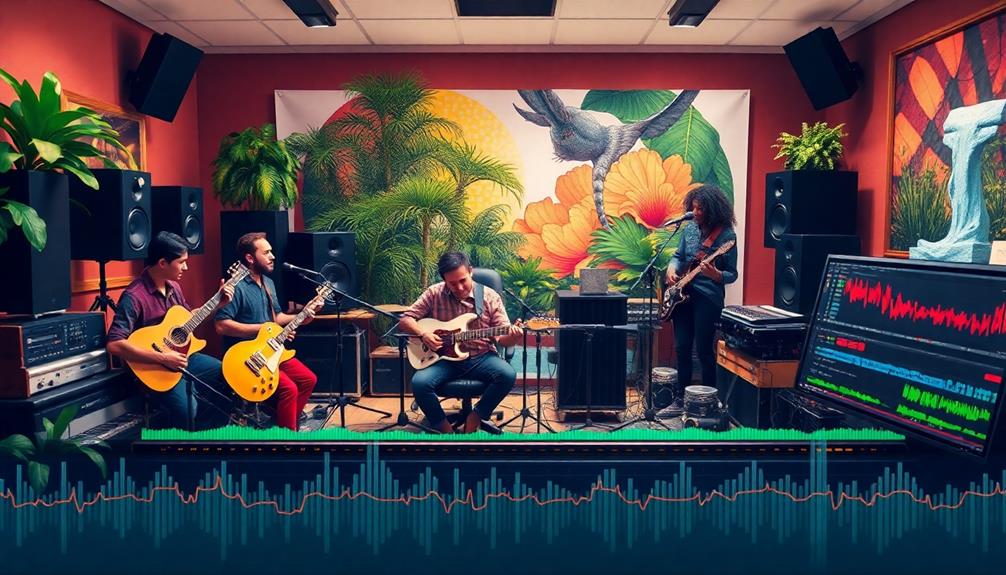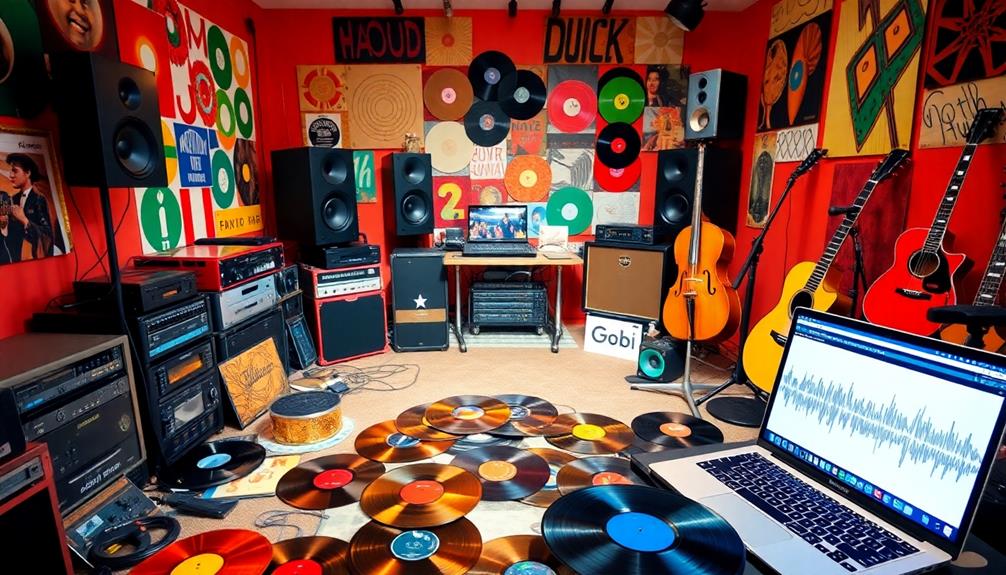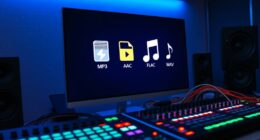Using field recordings in electronic music production can greatly enhance your tracks. These authentic sounds add unique textures and emotional depth, making your music stand out. You can capture everything from ambient nature sounds to urban noise, which enriches your soundscape. High-quality portable recorders and microphones are essential for clear audio. Experiment with layering and processing techniques like reverb and EQ to create engaging sound dynamics. Field recordings not only provide rich sonic material but also connect your audience to real-world experiences. If you want to discover more on this topic, explore various creative applications and techniques to level up your productions.
Key Takeaways
- Field recordings add unique sound layers, enhancing the distinct sonic identity and character of electronic music tracks.
- Utilize high-quality portable recorders and varied microphone types for superior audio capture in diverse environments.
- Experiment with different recording techniques to create rhythmic elements and immersive soundscapes that engage listeners emotionally.
- Incorporate natural and urban sounds to enrich compositions, providing cultural context and depth to the music.
- Post-process recordings with effects and EQ shaping to seamlessly integrate them into your electronic music productions.
Benefits of Field Recordings
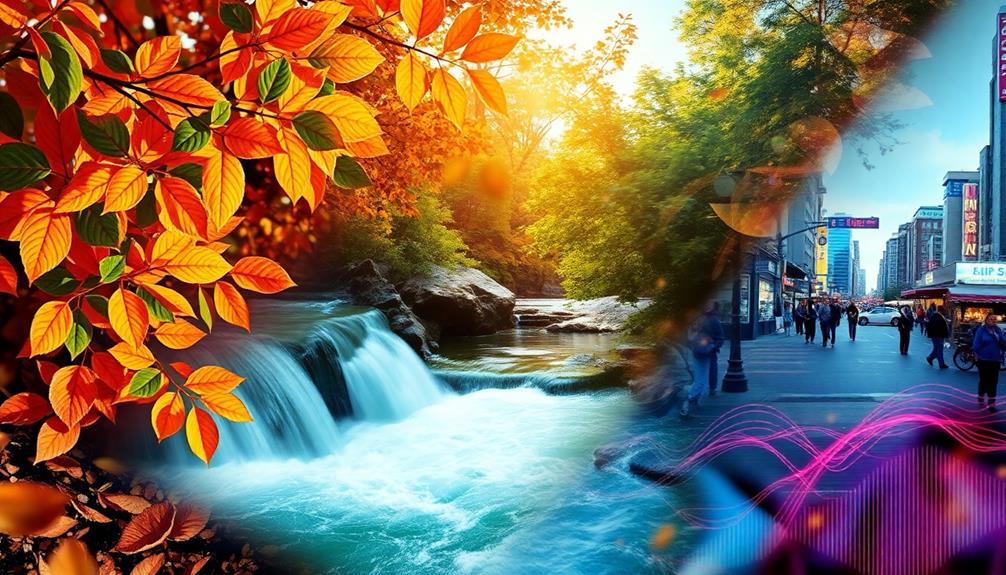
When you incorporate field recordings into your electronic music, you instantly add a unique layer of sound that sets your tracks apart. These recordings bring distinct sonic identities to your music, enhancing its personal character. By capturing sounds from various environments, you're able to weave your individual stories into your tracks, deepening the emotional resonance and narrative quality of your work.
Field recordings can inspire entire compositions, as the organic sounds often spark new ideas that synthesize beautifully with traditional electronic elements. This fusion not only fosters creativity but also encourages experimentation with diverse audio textures. You might find that a simple rustling leaf or bustling street can transform into innovative percussive elements or atmospheric soundscapes that elevate your music to new heights.
Moreover, integrating field recordings enhances the overall listening experience, creating immersive qualities that engage your audience on a deeper level. This connection can be pivotal in making your music memorable and impactful.
Essential Equipment for Recording

Incorporating field recordings into your electronic music requires the right tools to capture those unique sounds effectively. A basic setup includes a portable field recorder like the Tascam DR-05 or Zoom H5, both of which offer high-quality audio capture in a compact design. These devices are vital for efficient recording on the go.
For isolating specific sounds, consider using directional microphones, such as shotgun mics. If you want to capture vibrations from surfaces, contact mics are your best bet.
Don't forget about windshields and pop filters; these accessories are essential for outdoor recording, minimizing wind noise and plosive sounds to guarantee clearer audio quality.
If you're just starting out, smartphones equipped with recording apps can be a cost-effective alternative. They may not match professional gear, but they can still produce decent-quality field recordings easily.
Effective Recording Techniques

Capturing high-quality field recordings hinges on employing effective techniques that maximize your audio clarity and detail. To achieve this, you should use field recordings strategically, focusing on the right equipment and conditions.
Here are some effective techniques to contemplate:
- Use portable recorders like the Tascam DR-05 or Zoom H5 for their compactness and superior audio quality.
- Experiment with different microphone types, such as shotgun mics for capturing directional sounds or contact mics to record vibrations.
- Employ windshields and pop filters during outdoor sessions to minimize wind noise and plosive sounds, ensuring a cleaner audio signal.
Additionally, recording is a great way to explore various locations and times of day. Each environment offers unique ambient sounds that can enrich your electronic music.
Don't forget to familiarize yourself with post-processing software, as it allows for EQ adjustments and sound manipulation. This can enhance your recordings even further, ensuring they blend seamlessly into your music.
Types of Sounds to Capture
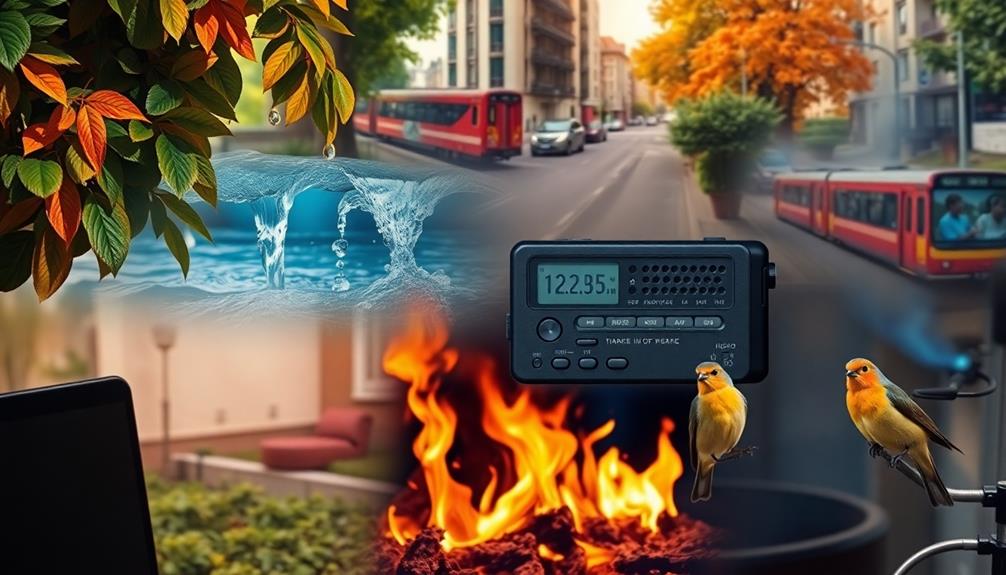
When you're out capturing field recordings, think about the natural sounds around you, like birds singing or leaves rustling.
Urban ambiance, such as traffic noises or chatter from a busy street, can also add a unique character to your music.
Both types of sounds can create rich textures and transport listeners to different environments.
Natural Environmental Sounds
Natural environmental sounds offer a rich tapestry of auditory experiences that can greatly enhance your electronic music production. By capturing sounds like birdsong, rustling leaves, and flowing water, you create an organic backdrop that adds emotional depth to your tracks. Specific events, such as rain falling or wind blowing, provide unique textures that make your compositions more interesting and varied.
Here are some types of natural environmental sounds to contemplate:
- Ambient sounds: Distant thunder or crickets chirping can serve as subtle layers, enriching your mix without overshadowing the main elements.
- Textural recordings: The sound of rustling leaves or flowing water introduces enchanting nuances that can inspire fresh musical ideas.
- Event-based captures: Recording specific occurrences like a storm or animal calls can inject unexpected elements into your work.
When you use EQ to shape these sounds, you can guarantee they fit seamlessly into your mix.
As you experiment with different environments, you'll discover a diverse sonic palette that complements various electronic music styles, ultimately pushing your creativity in exciting new directions.
Urban Ambiance Recordings
Urban ambiance recordings immerse you in the vibrant sounds of city life, offering a dynamic backdrop for your electronic music production. To create an authentic urban atmosphere, focus on capturing a variety of field recordings.
Start with the bustling streets, where the sounds of traffic, honking horns, and chatter from pedestrians paint a lively picture. Public transportation, like subway trains and buses, adds a rhythmic pulse that can enhance your tracks.
Don't forget the industrial noises, such as construction work and machinery, which contribute a gritty texture perfect for genres like techno and industrial. To further personalize your soundscapes, include snippets of conversations and human interactions, reflecting the diverse narratives found in urban environments.
Incorporate natural elements, too. Birds chirping in parks or wind rustling through trees blend beautifully with the mechanical backdrop.
Finally, explore unique sounds from local markets, street performers, and urban festivals. These recordings can provide rich rhythmic and melodic inspiration, making your music feel alive and connected to the city.
Creative Applications in Music
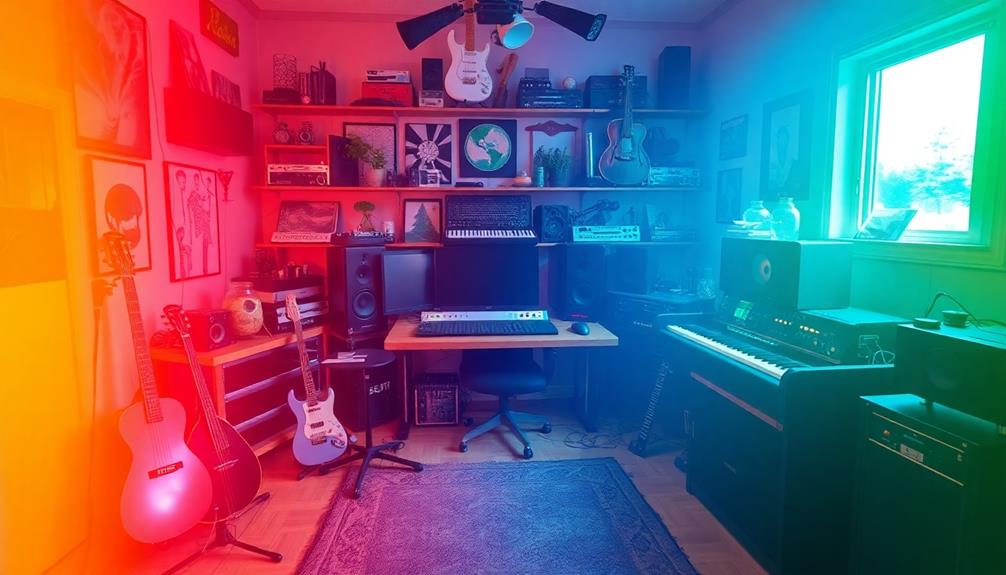
When you incorporate field recordings into your music, you open up a world of creative possibilities.
You can transform these sounds into rhythmic elements, design ambient soundscapes, or craft unique melodic textures that set your tracks apart.
Rhythmic Elements Creation
Field recordings offer a treasure trove of possibilities for creating rhythmic elements in electronic music. By slicing and arranging these audio clips, you can develop unique percussion patterns that enhance the groove of your track.
Utilizing found sounds, such as footsteps, claps, or industrial noises, can yield innovative drum sounds that inject character and authenticity into your compositions.
Here are some effective techniques to evaluate:
- Experiment with pitch and tempo: Altering these elements allows you to create distinct rhythmic loops that can serve as the foundation of your song.
- Layer multiple recordings: Combine various field recordings with different levels of reverb and delay to craft complex rhythmic textures that enrich your soundscape.
- Manipulate envelope settings: Adjusting attack and decay can shape the dynamics of your sounds, turning them into effective rhythmic components in your production.
Ambient Soundscapes Design
Creating ambient soundscapes opens up a world of sonic possibilities, inviting you to transport listeners to diverse environments through carefully layered recordings. By using field recordings of nature sounds like wind, water, and wildlife, you can craft immersive experiences that feel authentic and engaging.
Artists like Brian Eno have shown how manipulating these recordings with effects such as reverb and delay enhances the ethereal quality of ambient music, resulting in rich, expansive textures.
Incorporating binaural recording techniques allows you to create a three-dimensional listening experience, making your audience feel as if they're truly present within the soundscape. This not only enhances emotional engagement but also deepens the connection to your work.
Adding human elements, like captured spoken word or laughter, can evoke relatability and warmth, making your compositions resonate on a personal level.
Experimenting with various sound sources—from bustling urban environments to serene natural settings—encourages unique combinations that can redefine traditional ambient music.
Unique Melodic Textures
Incorporating unique melodic textures into your music can elevate your compositions and set them apart. By leveraging field recordings, you can transform everyday sounds into enchanting musical elements. Manipulating pitch and applying effects allows for innovative sound design that enriches your tracks.
Here are a few ways to use field recordings creatively:
- Layering: Blend field recordings with traditional instruments to create immersive soundscapes that evoke specific emotions.
- Recontextualization: Use techniques like time-stretching and granular synthesis to turn field recordings into new melodic ideas that mesh seamlessly with electronic elements.
- Rhythmic Foundations: Edit and loop nature sounds or urban noise to create compelling percussion that drives your composition.
Incorporating found sounds into your melodic lines not only personalizes your music but also connects it to cultural contexts, enhancing listener engagement.
Integrating Recordings Into Productions
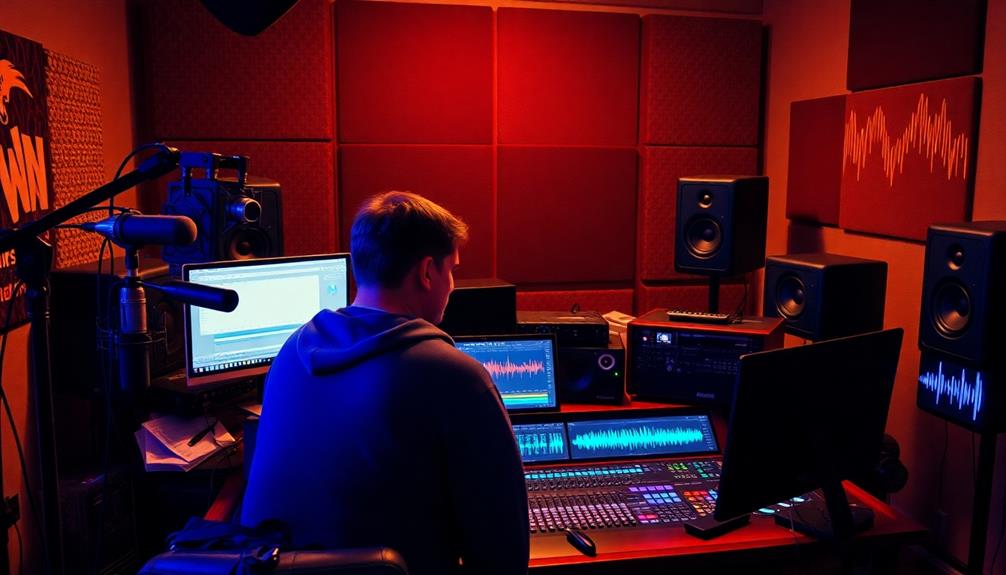
When you integrate field recordings into your electronic music productions, you can transform your soundscapes and enhance emotional depth. Field recordings became a powerful tool for adding texture and storytelling to your compositions.
Begin by layering these recordings with traditional instruments, creating a rich auditory experience that captivates your audience.
Utilize your digital audio workstation (DAW) to manipulate the recordings, adjusting pitch and tempo while applying effects like reverb or delay. This allows you to craft unique sound textures that stand out in your music production.
Experiment with panning strategies to give a three-dimensional feel, placing different sounds in distinct spatial locations.
You can also incorporate rhythmic elements by slicing field recordings into smaller samples. Arrange these snippets in a sequencer to form engaging percussive beats, blending organic sounds with electronic elements.
To make the integration process smoother, regularly review and curate your field recording library. Label each sound with context, so you can easily access them for future projects.
Processing Techniques for Enhancement

Field recordings can greatly benefit from specific processing techniques that enhance their clarity and integration within your electronic music productions. By employing the right methods, you can transform these recordings into essential elements of your tracks. Here are a few effective processing techniques to take into account:
- EQ: Filter out unwanted frequencies to enhance clarity and guarantee your field recordings blend seamlessly with other musical elements.
- Gating: Isolate specific sounds from your recordings, managing dynamic range and reducing background noise while maintaining a natural sound shift.
- Reverb and Delay: Create immersive soundscapes, adding depth and complexity to your musical arrangements.
Additionally, don't overlook pitch adjustment through transposition. This can alter the perception of your field recordings, lending emotional weight and unique textures to your compositions.
Experimenting with panning strategies also helps create a three-dimensional sound field, enriching the listening experience by placing your recordings dynamically within the stereo landscape.
Emotional Impact of Sound Design
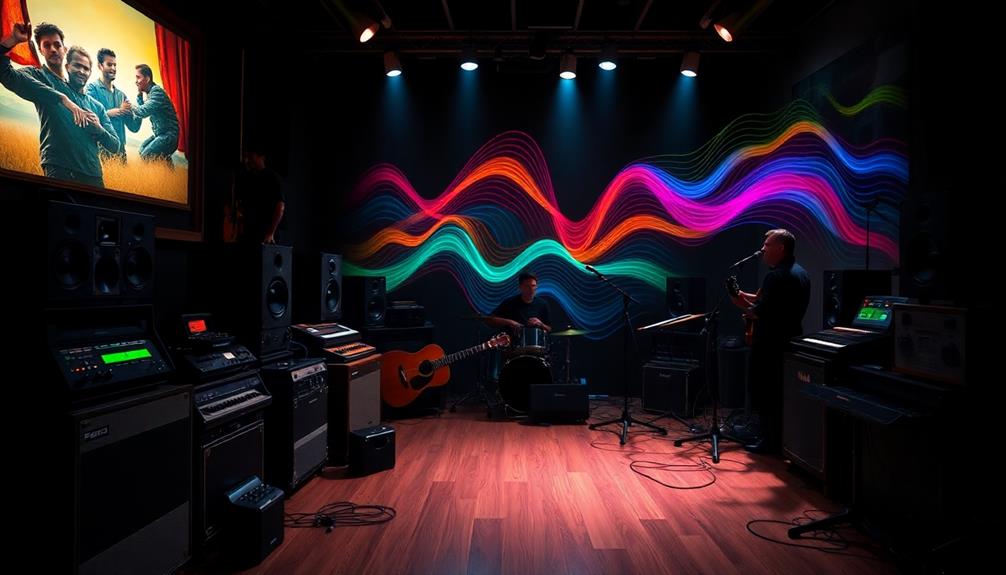
Sound design plays an essential role in shaping the emotional landscape of electronic music, especially through the use of field recordings. As a DJ and producer, you can create a tangible connection between your audience and real-world experiences, evoking nostalgia and personal memories. By manipulating pitch and sound, you can alter perceptions and evoke distinct feelings, allowing your tracks to resonate deeply with listeners.
Layering field recordings with musical elements enhances the depth of your compositions, resulting in a richer sonic palette. This technique elicits stronger emotional responses, guiding your audience on an emotional journey. Integrating ambient sounds from nature or urban environments can establish specific moods or atmospheres, drawing listeners into the world you're creating.
Furthermore, using found sounds as rhythmic or melodic components transforms everyday noises into expressive musical elements. This unique emotional narrative can make your music more relatable and impactful.
Frequently Asked Questions
What Are Field Recordings in Music?
Field recordings in music capture real-world sounds, like nature or urban noise. You can integrate these unique audio elements into your compositions, adding depth and authenticity while enhancing your creative expression and sound design.
How to Mix Field Recordings?
To mix field recordings effectively, organize them clearly, apply EQ to enhance clarity, layer them strategically, use reverb and delay for depth, and pan them in the stereo field for a dynamic listening experience.
What Is Another Name for Field Recording?
You won't believe it, but field recording's also known as "location sound"! It's all about capturing those amazing audio snippets from real-life environments, turning everyday sounds into creative treasures that spark your imagination!
What Does It Mean to Say Field Recordings Capture Ambient Sounds?
When we say field recordings capture ambient sounds, we mean they document the natural environment and human activities. You're hearing the essence of a place, which adds depth and texture to any auditory experience.
Conclusion
Incorporating field recordings into your electronic music can transform your soundscape, breathing life into your tracks. Imagine the rustle of leaves or a distant train adding depth to your compositions. It's not just about the sounds; it's about the stories they tell. So, grab your recorder and venture outside—let the world be your instrument. By blending these unique sounds with your creativity, you'll craft music that resonates, captivates, and connects with listeners on a deeper level.

